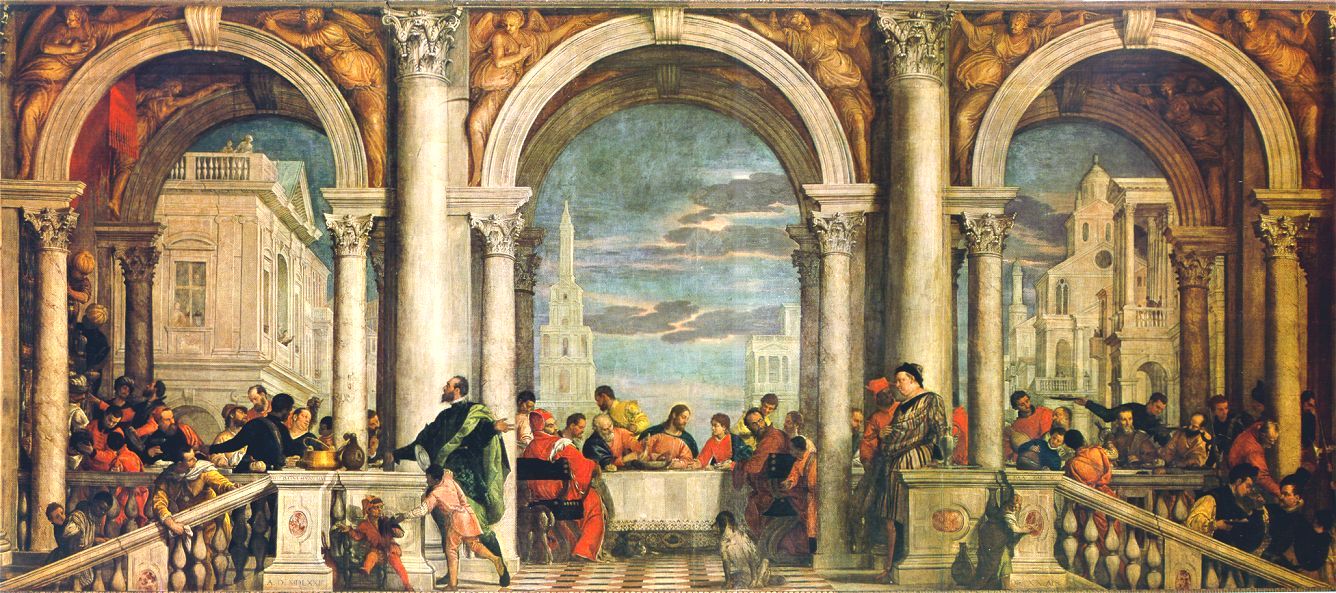
(1573), by Paolo Veronese (1528-1588)—click to enlarge.
Note on the following: In 1573, the Venetian Renaissance artist Paolo Veronese was called before a tribunal of the Inquisition to defend his painting The Last Supper. The tribunals were convened to combat "heresy, including sorcery, immorality, blasphemy, Judaizing and witchcraft, as well for censorship of printed literature." Torture was often employed by the inquisitors to gain a confession, after which the accused faced public execution by being burned at the stake. The most famous subject of the Roman (Italian) Inquisition was Galileo Galilei, who in his writings promoted the Copernican heresy that the earth revolves around the sun, much in the same way that today's heretics claim humans evolved from non-human primates.
The word "German" in the following testimony meant, in the Catholic Italy of 1573, "Protestant." Think of the way Sarah Palin and contemporary medieval ultra-bigots use the word "Muslim" and you'll get the gist.
Q. What signify those armed men dressed in the fashion of Germany, with halberds in their hands?
A. It is necessary here that I should say a score of words.
Q. Say them.
A. We painters use the same license as poets and madmen, and I represented those halberdiers, the one drinking, the other eating at the foot of the stairs, but both ready to do their duty, because it seemed to me suitable and possible that the master of the house, who as I have been told was rich and magnificent, would have such servants.
Q. And the one who is dressed as a jester with a parrot on his wrist, why did you put him into the picture?
A. He is there as an ornament, as it is usual to insert such figures.
Q. Who are the persons at the table of Our Lord?
A. The twelve apostles.
Q. What is Saint Peter doing, who is the first?
A. He is carving the lamb in order to pass it to the other part of the table.
Q. What is he doing who comes next?
A. He holds a plate to see what Saint Peter will give him.
Q. Tell us what the third is doing.
A. He is picking his teeth with a fork.
Q. And who are really the persons whom you admit to have been present at this Supper?
A. I believe that there was only Christ and His Apostles; but when I have some space left over in a picture I adorn it with figures of my own invention.
Q. Did some person order you to paint Germans, buffoons, and other similar figures in this picture?
A. No, but I was commissioned to adorn it as I thought proper; now it is very large and can contain many figures.
Q. Should not the ornaments which you were accustomed to paint in pictures be suitable and in direct relation to the subject, or are they left to your fancy, quite without discretion or reason?
A. I paint my pictures with all the considerations which are natural to my intelligence, and according as my intelligence understands them.
Q. Does it seem suitable to you, in the Last Supper of our Lord, to represent buffoons, drunken Germans, dwarfs, and other such absurdities?
A. Certainly not.
Q. Then why have you done it?
A. I did it on the supposition that those people were outside the room in which the Supper was taking place.
Q. Do you not know that in Germany and other countries infested by heresy, it is habitual, by means of pictures full of absurdities, to vilify and turn to ridicule the things of the Holy Catholic Church, in order to teach false doctrine to ignorant people who have no common sense?
A. I agree that it is wrong, but I repeat what I have said, that it is my duty to follow the examples given me by my masters.
Q. Well, what did your masters paint? Things of this kind, perhaps?
A. In Rome, in the Pope's Chapel, Michelangelo has represented Our Lord, His Mother, St. John, St. Peter, and the celestial court; and he has represented all these personages nude, including the Virgin Mary, and in various attitudes not inspired by the most profound religious feeling.
Q. Do you not understand that in representing the Last Judgment, in which it is a mistake to suppose that clothes are worn, there was no reason for painting any? But in these figures what is there that is not inspired by the Holy Spirit? There are neither buffoons, dogs, weapons, nor other absurdities. Do you think, therefore, according to this or that view, that you did well in so painting your picture, and will you try to prove that it is a good and decent thing?
A. No, my most Illustrious Sirs; I do not pretend to prove it, but I had not thought that I was doing wrong; I had never taken so many things into consideration. I had been far from imaging such a great disorder, all the more as I had placed these buffoons outside the room in which Our Lord was sitting.
These things having been said, the judges pronounced that the aforesaid Paolo should be obliged to correct his picture within the space of three months from the date of the reprimand, according to the judgments and decision of the Sacred Court, and altogether at the expense of the said Paolo.
"Et ita decreverunt omni melius modo." (And so they decided everything for the best!)
For whatever reasons, Veronese lived to paint again. Instead of making the changes, he changed the name of the painting from The Last Supper to Feast in the House of Levi.
Fundamentalists are the same in every age. Whether they are flying planes into buildings or burning Korans, intolerance if unopposed, always leads to tyranny and oppression.
Always.
0 comments:
Post a Comment